Affiliate Disclosure: This post contains affiliate links, which means if you click on them and make a purchase, I will receive a small commission (at no extra charge to you).
When a marketing-savvy author friend said recently that they were removing their content-rich, SEO-friendly blog from their site and relocating it to Substack, I nearly gasped. (And I’m not even a drama queen.)
This was part of their plan to use Substack as their email newsletter service.
“Why?” I asked.
“Because I want to monetize* my newsletter and Substack makes that easy to do,” they replied. (*Monetize: marketing buzzword for “earn money from.”)
I explained why I didn’t think this was in their best interest, but the author was locked in. Logic be damned.
I’ve since had this “Substack for authors” conversation with several book marketing coaching clients and, quite recently, in person with a group of local author friends over lunch.
Here’s what I’ve been telling them.
What’s Substack?
Substack is a newsletter platform. People who use Substack benefit from:
- Free use until they start charging for their newsletter. Then Substack takes 10% of subscription fees, while Stripe, its payment provider, takes another 2.9% plus 30 cents per payment and 0.5% for recurring payments.
- A newsletter network that makes it easy for Substack publishers to recommend each other’s newsletters.
- An online home for each newsletter publisher’s archive of back issues. Think of each of these issues as a blog post.

Why authors are attracted to Substack
Here’s what authors tell me about why they’re considering Substack or have already signed on with the service.
Everybody’s doing it.
Yes, some people with large followings are using Substack. I’ll bet a bunch of your author friends are, too.
But, let’s remember the words of my wise mother: “If everyone jumped off a bridge, would you jump, too?”
“Everybody’s doing it” is a shallow rationalization that doesn’t work in this situation any more than it does when it comes to combovers for balding men.
With book marketing, what works for one author doesn’t necessarily work for another. How well you execute makes a difference, too.
With book marketing, what works for one author doesn’t necessarily work for another. How well you execute makes a difference, too.Click to tweetIt’s easy to set up.
This is true. You can be up and running quickly.
That’s partly because Substack is so basic. It lacks important features offered by other more conventional email marketing service providers, including the ability to personalize messages by adding a subscriber’s first name to a salutation.
It’s free.
That’s attractive to many.
But several other email service providers, including mine, provide far more functionality at the free level. (I use ConvertKit, which is free for up to 1,000 subscribers.)
But that’s okay. If you’re just starting out, the simplest and least powerful service available might be a good fit for you.
I want to monetize my newsletter.
Yeah, well, good luck with that.
Most authors scramble to get unpaid subscribers.
Generating enough paid subscribers to make a difference is harder than you might think. Be sure you’ve got a marketing plan in place for it.
Substack makes it easy for other newsletter publishers to recommend mine.
That’s such a smart idea that my email service provider, ConvertKit, offers that feature now, too.
Readers can search for and find my newsletter from the Substack home page.
This is pretty cool…in theory.
I’ve found it hard to uncover lesser-known newsletters when all I’ve got is the topic, though.
I’ve played around with that function and discovered that you aren’t likely to be found unless someone is searching for your name or newsletter title. The most popular newsletters show up first in various categories. To find a less-popular one, you have to scroll … and scroll … and scroll.
Who has time for that?
Clearly, there are plenty of reasons to like Substack. But there are a few reasons not to like it, too.
4 reasons I’m not a fan of Substack for authors
Here’s why I discourage authors and others – especially bloggers – from using Substack for email marketing and blogging.
1. Placing your best content on someone else’s platform boosts that site’s SEO while undermining yours.
Let’s presume you’re giving your subscribers the information they need. They love it! They recommend your newsletter to others!
All – all – of the resulting traffic completely bypasses your website and goes to Substack.
Substack, not your website, benefits from all of the SEO (search engine optimization — what you do to your website so that it gets found by search engines) value generated by the newsletter content you create specifically to appeal to your target audience. That type of targeted content is precisely what you need for your site to show up near the top of online searches for your topic.
Why would you undermine your brand online to support another company’s business?
You’re redirecting traffic away from your site. Not. Smart.
2. Substack doesn’t offer enough automation.
As you learn more about the power of email marketing, you’ll want your email service provider to perform a range of pre-determined functions. You tell it what to do once, and the system automates it for you.
For example, one best practice in email marketing for businesses of all sizes involves sending a series of welcome email messages to new subscribers on a schedule that’s unique to when they subscribed. Each message shares new information that’s relevant to your subscriber.
Substack can send a single welcome message to a new subscriber, but that’s it.
This lack of automation isn’t a deal breaker initially. You might not want sophistication if you’re using email marketing for the first time. But as your success grows, you’ll want more power.
(For more on that, read “Book review: Newsletter Ninja: How to Become an Author Mailing List Expert.”)
3. Monetizing is a lot harder than it looks.
The hype around how Substack makes it easy to earn from paying subscribers is incredibly misleading.
We’re accustomed to subscribing to free newsletters that might offer value. But paying for a “premium” version of that content requires a big shift that most aren’t ready for yet. And it sure doesn’t happen instantly.
I need to get value from your content before deciding if I want to pay you for more of it. Determining if the value is there takes time.
In addition, maybe it’s just me, but I don’t like how many of these newsletters persistently beg for money.
As a user, I find the constant requests to pay for the newsletter or “premium” add-ons tacky and intrusive. How do you build relationships with your subscribers when you’re annoying them?
Here’s an example of what I see in Substack newsletters when the publisher decides to use theirs to earn money.
This is from a writer who added me to their subscriber list (I did not opt-in). I’ve blocked out the newsletter title and the introductory text so the sender can’t be identified; I’ve left the requests to pay for more issues where it appears in the beginning of the newsletter. It appears at the end, too.
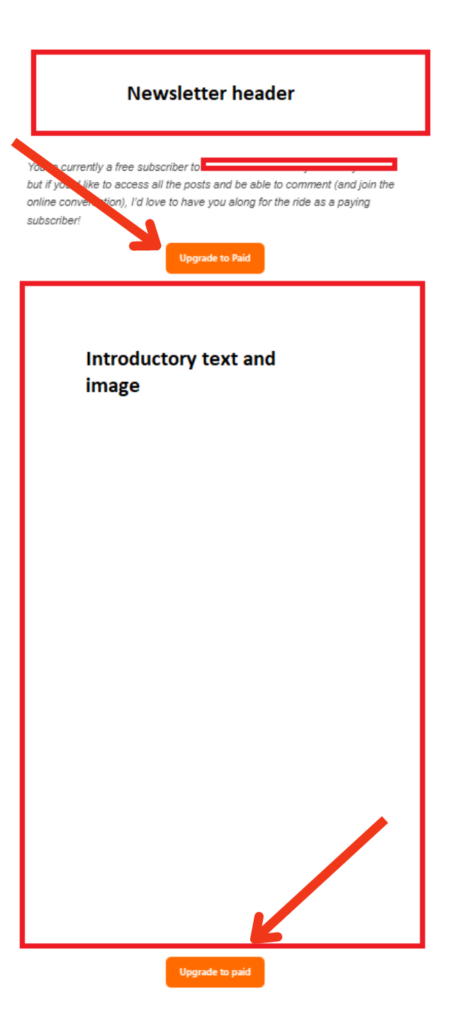
Repeatedly asking for money is no classier than asking your dinner guests to pay for their meal as they’re leaving at the end of the evening.
4. You’re hosting all of your content on something you can’t control.
Admittedly, I might be a little paranoid about this.
But what if Substack crashes and you lose all of your archived content?
I feel like I have more control over that with my own little website, where I can constantly and consistently monitor all threats and keep them from taking my site down.
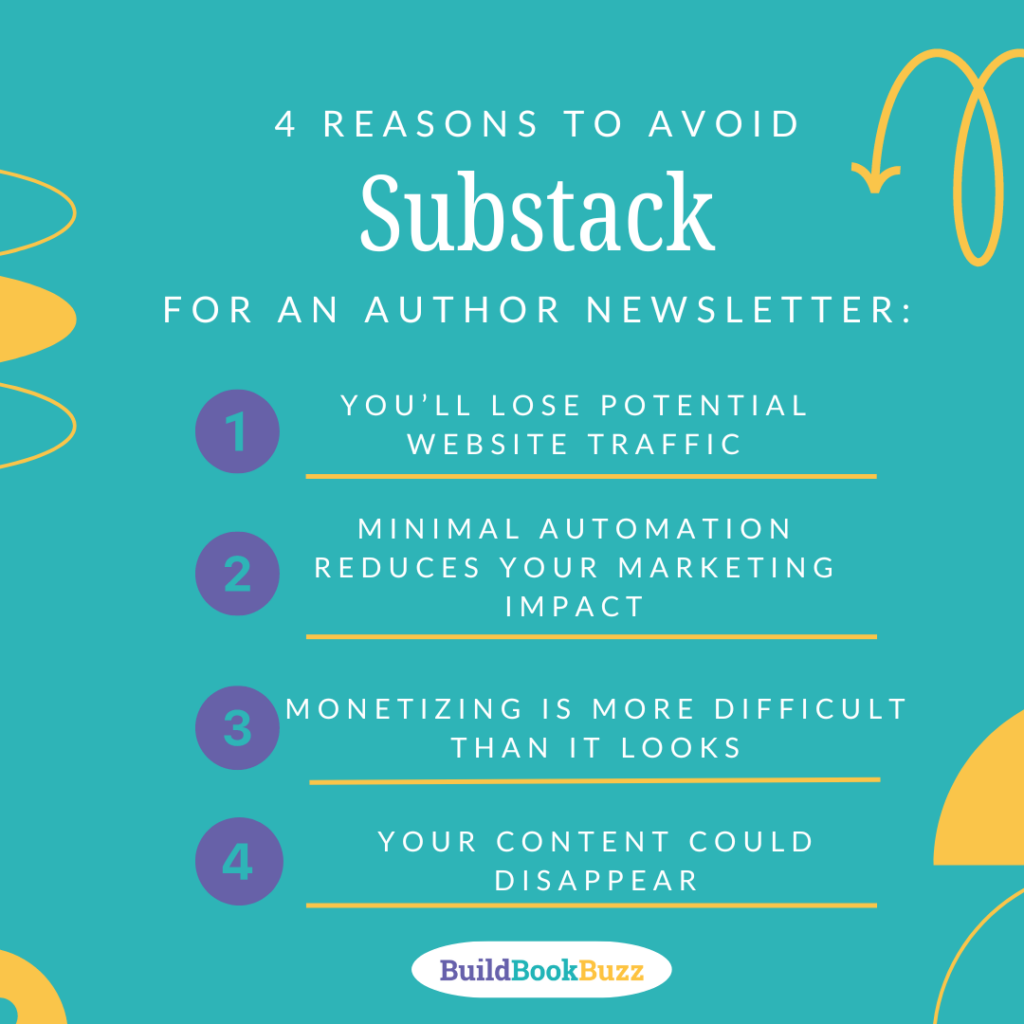
Should you sign up for Substack for authors?
I realize that these negatives might not outweigh what you see as positives. So, should you sign on with Substack, or should you spend time comparing it to alternatives?
I don’t recommend making an important business decision based on what “everyone else” is doing.
Instead, whether it relates to email marketing or the latest social network or whether you should host a podcast, I always recommend learning as much as possible about a tactic and its options before making a choice.
Instead of chasing the latest bright, shiny object, consider where you’d like to be with email marketing in one, three, and five years. Then explore enough solutions to understand which will do the most to get you there.
Want to experience ConvertKit, the email marketing tool designed for creators like us? Use my affiliate link to try it for free.
FAQs about Substack for Authors
1. What exactly is Substack?
Substack is a newsletter platform that allows users to create and distribute newsletters to subscribers. It offers features such as free usage until monetization, a network for newsletter recommendations, and an archive for back issues.
2. Why are authors attracted to Substack?
Authors are drawn to Substack for several reasons:
- It’s a popular choice among authors and peers.
- Setting up a newsletter on Substack is quick and easy.
- Substack offers a free plan, which is appealing for those starting out.
- Many authors wants to monetize their newsletters, and Substack provides tools for this.
- It facilitates cross-promotion among newsletter publishers and offers visibility through its homepage.
3. What are reasons for authors to avoid Substack?
There are several reasons why Substack might not be the best choice for authors:
- It redirects traffic away from your own website, potentially undermining your brand and SEO.
- Substack lacks advanced automation features that are common with other email marketing platforms. This limits how much your email marketing will contribute to your goals.
- The constant payment solicitations within Substack newsletters can come across as inappropriate.
- Hosting content solely on Substack means relinquishing control over your content and risking potential loss if the platform has issues.
4. How does Substack compare to other email marketing solutions?
While Substack has its merits, it’s essential for authors to weigh its pros and cons against other email marketing solutions.
Be sure to consider factors that include control over content, automation capabilities, and how well the platform is aligned with your long-term goals.
5. Should authors choose Substack based on its popularity alone?
No, popularity shouldn’t be the sole factor in choosing an email marketing platform.
Authors should assess their specific needs, long-term objectives, and the various service provider capabilities before making a decision.
It’s crucial to put informed decision-making over blindly following trends.
I know that many of you love Substack. Please tell us why in a comment!
]]>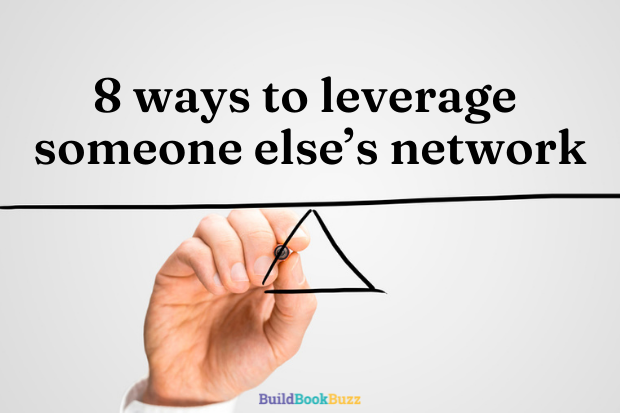 A friend and I were brainstorming recently about how to expand her network so she has a stronger platform when she introduces a new course. We talked about a few different options, but my favorite approach, I said, is to leverage someone else’s network.
Because many of her friends have influence with people the course is designed to help, I suggested she start by asking those friends to help spread the word. It's a quick and easy way to begin moving forward.
But piggybacking onto someone else’s platform can – and should – involve far more than asking friends for support. The process is all about cross-promotion and collaboration.]]>
A friend and I were brainstorming recently about how to expand her network so she has a stronger platform when she introduces a new course. We talked about a few different options, but my favorite approach, I said, is to leverage someone else’s network.
Because many of her friends have influence with people the course is designed to help, I suggested she start by asking those friends to help spread the word. It's a quick and easy way to begin moving forward.
But piggybacking onto someone else’s platform can – and should – involve far more than asking friends for support. The process is all about cross-promotion and collaboration.]]>Because many of her friends have influence with people the course is designed to help, I suggested she start by asking those friends to help spread the word. It’s a quick and easy way to begin moving forward.
But piggybacking onto someone else’s platform can – and should – involve far more than asking friends for support. The process is all about cross-promotion and collaboration.
How to leverage someone else’s network
It’s a smart strategy if you want to sell more books or other products, build an email list, or increase your social media follower count.
Here are eight ways to use the power of someone else’s network to reach your book marketing goals.
1. Do an Instagram takeover.
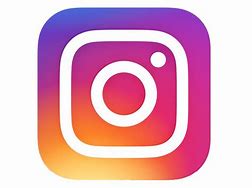 With an Instagram takeover, you literally take over someone’s Instagram account, posting your content instead of theirs. Create Instagram Stories and posts, or go live.
With an Instagram takeover, you literally take over someone’s Instagram account, posting your content instead of theirs. Create Instagram Stories and posts, or go live.
Keep in mind that this needs to be a mutually beneficial opportunity. Your host – perhaps another author in your genre – wants to know that you:
- Have an engaged audience that you’ll bring with you
- Will deliver quality, relevant content
- Will promote the takeover to your network
Keep the momentum going by arranging for your host to take over your account the following week.
2. Propose a newsletter swap.
A newsletter swap is a smart way to leverage someone else’s network while building relationships with others who reach your ideal readers.
With a newsletter swap, you and the influencer agree to promote each other’s books, programs, or products in your email newsletters.
I’ve got the how-to details in “How to do an author newsletter swap.”
3. Be a podcast guest.
Being any kind of guest is a great way to expand your reach, but I consider a podcast interview to be one of the easiest. Just show up and talk about something you know a lot about.
You’ll want to be thoughtful about what you say, of course. I always recommend working to communicate two or three key messages when you’re interviewed. Write them down ahead of time, and find ways to work each in at least once during the conversation.
Be sure to read “Message development: Know what you want to say and how to say it” first.
Support the podcast by promoting your appearance to your network so this is a win-win for all – you reach the podcast’s audience, but you also introduce your connections to the podcaster and their show.
4. Guest blog.
If you been hanging around here with me for a while, you know I’m a fan of guest blogging for several reasons.
When you write an article for someone else’s site, you’re providing an opportunity for your ideal readers to sample your writing.
In addition, your host will most likely include a link to your book on Amazon or another retail site as part of your short guest blogger bio. (Learn the other reasons I love guest blogging in “4 reasons to embrace guest blogging.”)
Be careful to deliver a quality article that you’ve edited and carefully proofread. This isn’t an opportunity to “phone it in.” This should be a showpiece, not something you did so you could cross it off a list.
Get tips for being the best guest blogger ever in my free Guest Blogging Cheat Sheet.
5. Speak at a virtual or in-person summit.
I do this once or twice a year, and I’m increasingly particular about the events I speak at so that I can maximize my time and reach.
I like to speak at events featuring other presenters who I’m fairly confident will promote the event to their networks.
When all speakers share summit news with their followers, everyone benefits. When they don’t, people in their networks aren’t exposed to helpful presentations and speakers, and other presenters don’t expand their reach and influence.
Speaking at a summit and offering free downloadable tips to attendees is one of the best ways I have for building my email list.
I usually create a new advice-packed “lead magnet” related to my presentation topic and require people to provide their email address to download it. They get bonus how-to information and my free, weekly, book marketing newsletter, and I can help more authors with articles like this one.
(Get fiction lead magnet ideas here and nonfiction ideas here.)
6. Bring well-connected people to your audience.
Do you have a blog or a podcast? Do you love using Facebook or Instagram Live? Invite influencers and others who share your audience to be your guest.
This helps you create quality content your followers will appreciate while your guest brings their audience to you, even while they’re connecting with yours.
Expand the impact by providing your guests with event text and images they can use to promote their guest appearances both before and after the events.
7. Get publicity.
Publicity – news media exposure – is the OG of audience leveraging.
Pre-social media, using publicity strategies to reach news outlets’ readers, viewers, and listeners was one of the only ways you could piggyback onto another’s platform.
Why should you work to reach audiences served by newspapers, magazines, radio and TV stations, and content sites? Publicity will help you:
- Get discovered
- Be seen as an authority and expert
- Sell more books
- Appeal to libraries and bookstores
- Expand your platform
Because I’m a national award-winning former publicist, I’ve written about publicity quite a bit on this site. Scroll through the articles here, and be sure to register for my author publicity course, “Get Quoted: A Journalist’s Strategies for Using HARO to Snag Book Publicity.”
8. Propose a joint venture.
The dictionary defines a joint venture as “a commercial enterprise undertaken jointly by two or more parties which otherwise retain their distinct identities.”
For us, it’s a mutually beneficial arrangement where you partner equally with someone else to achieve a common goal.
Let’s go back to my friend’s situation. If her course is designed for people like you – my audience – she could propose that I host a free training with her that teaches something helpful and previews the course.
We agree that in exchange for access to my audience, we will split the income she earns from course registrations generated by our joint event. She expands her reach, I provide you with useful free training, and we’ve both earned something in the process.
That’s a solid joint venture.
Which of these options works for you?
You’re better suited to some of these than others, right? If you don’t have a blog or podcast, you won’t be inviting people to write for you and you won’t be interviewing them on air.
But if you’re killing it on Instagram, a takeover there might become your new best tactic. Love talking about the writing craft or your book’s topic? Look into being a podcast guest.
It doesn’t matter how many of these you’re willing to explore. What matters is that you pick at least one – just one – and learn how to make it happen. You’ll move in the right direction – forward!
Which of these works best for you already? Which one are you going to try now? Please tell us in a comment.
]]>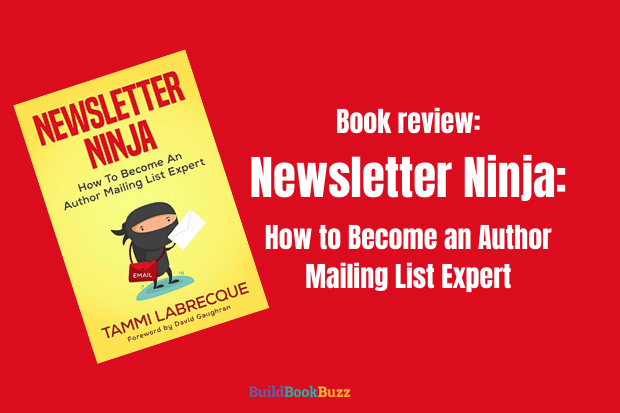 I’d love to see more of you use email marketing to build relationships with readers in a way that will help you sell more books.
As with just about every book marketing tactic, there’s a right way and a wrong way to use email marketing as an author. And, not surprisingly, it’s not as simple as finding someone who knows how to add an email form to your website.
You also need to know how to encourage people to add themselves to your list, and you have to send email messages that “speak” to them.
That's why I'm reviewing Newsletter Ninja: How to Become an Author Mailing List Expert by Tammi Labrecque. I think it will help with nearly every aspect of author email marketing.]]>
I’d love to see more of you use email marketing to build relationships with readers in a way that will help you sell more books.
As with just about every book marketing tactic, there’s a right way and a wrong way to use email marketing as an author. And, not surprisingly, it’s not as simple as finding someone who knows how to add an email form to your website.
You also need to know how to encourage people to add themselves to your list, and you have to send email messages that “speak” to them.
That's why I'm reviewing Newsletter Ninja: How to Become an Author Mailing List Expert by Tammi Labrecque. I think it will help with nearly every aspect of author email marketing.]]>I’d love to see more of you use email marketing to build relationships with readers in a way that will help you sell more books.
As with just about every book marketing tactic, there’s a right way and a wrong way to use email marketing as an author. And, not surprisingly, it’s not as simple as finding someone who knows how to add an email form to your website.
You also need to know how to encourage people to add themselves to your list, and you have to send email messages that “speak” to them.
That’s why I’m reviewing Newsletter Ninja: How to Become an Author Mailing List Expert by Tammi Labrecque. I think it will help with nearly every aspect of author email marketing.
Who will find this book helpful?
Newsletter Ninja will help authors at several different knowledge levels. They are people who:
- Aren’t convinced it’s a smart marketing tactic
- Know they should do it, but don’t know much more than that
- Make building an email list a priority and send a regular newsletter
- Are more experienced email marketers, but know they can learn more about how to use it even more effectively
The book covers everything you need to know and understand about using email marketing as an author with one exception. It doesn’t show you how to get set up with an email collection form on your website.
That’s because the process isn’t uniform. It varies for each email service provider, so you’ll need to use your provider’s tutorials and support staff for that. (If you’re not a do-it-yourselfer, ask a friend to recommend someone who can do it for you.)
What you can expect from Newsletter Ninja
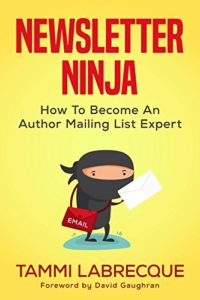 There’s a lot to like about this book, including the author’s friendly, conversational tone. She’s an excellent writer, which makes it easy to learn from her.
There’s a lot to like about this book, including the author’s friendly, conversational tone. She’s an excellent writer, which makes it easy to learn from her.
There’s something for every author in this book, no matter where you are in the spectrum. Not using email at all? She’ll talk you into it. Power user? You’ll love the last few chapters about re-engagement and split testing.
If you’re using email marketing already, you’ll learn how to do it better — and you’ll learn how to become a more sophisticated user, too.
One of the beauties of this book’s contents is that you can stop reading as soon as you feel like you’re getting in over your head. Use what you’ve learned to improve what you’re already doing. Then, with that mastered, come back to the book and read more about what is, for you, next-level author email marketing.
Throughout the book, Labrecque makes it clear that she knows that not everyone understands industry buzzwords. She defines many of the terms she uses, such as “cookie” (what she calls that incentive you offer readers in exchange for their email address), and “onboarding sequence.”
This is important because if you get confused by or hung up on the buzzwords, you might stop reading. The author brings you along with her gently, all the while reassuring you that she is in tune with you. I like that!
A few gems
I’m sure it’s not surprising that I like a book that repeats some of the things I tell the authors I coach. One of these is in Chapter 1: “Do not make business decisions based on your own consumer behavior.” You are not your reader, she reminds us.
In Chapter 4, she tells us that the primary purpose of an author newsletter isn’t to sell books. It’s to build superfans. With those superfan relationships in place, you’ll sell books, but you don’t want to reach out to your subscribers only when you’ve got a new book for them to buy.
In Chapter 7, Labrecque explains the newsletter triad: you want your subscribers to open, click, reply.
If you’re sending a newsletter, is that happening for you? Do you know what percentage of your messages get opened? Are subscribers clicking on your links? Are they replying to your messages? If not, Newsletter Ninja will help you fix that.
Labrecque also offers an extensive list of helpful links to more information online, taking your learning outside the pages of her book to other websites.
For fiction and nonfiction authors alike
I was surprised to discover that in this book, Labrecque focuses on fiction, with no reference to nonfiction authors — at least none that I could find. The book’s description doesn’t say it’s specifically for fiction writers, and that’s not clear from the table of contents, either.
Even so, we nonfiction authors are smart enough to see past the fiction examples and stories and focus on the valuable lessons, regardless of how they’re packaged. You will learn as much as any novelist — you just won’t have the “for instances” that could help bring the concepts to life for you.
One topic that’s fiction-specific and less helpful to nonfiction authors is the Chapter 11 discussion about what to give fans to encourage them to sign up for your newsletter. Labrecque’s suggestions — a novella or prequel, for example — let readers sample the author’s writing.
I’d recommend considering other, more creative options, in light of recent research suggesting that short-form content works best. Labrecque did offer a few non-writing-sample alternatives, and I encourage you to consider that approach, too, whether you write fiction or nonfiction.
Two thumbs up
In college course terms, this book starts out at the 101 level, moves to 201, and ends at 301. You might not be comfortable moving through all levels right now. If you’re a beginner, start with the basics before implementing more sophisticated tactics.
You’ll want to know everything in the book eventually, but it’s OK to learn at your own pace.
I highly recommend Newsletter Ninja: How to Become an Author Mailing List Expert. I’m excited about implementing some of the ideas I got from it, too!
Are you using email marketing? Are you getting the results you want? Tell us about it in a comment!
Tip of the Month
 I like to share a “Tip of the Month,” a free resource or tool for authors, on the last Wednesday of the month.
I like to share a “Tip of the Month,” a free resource or tool for authors, on the last Wednesday of the month.
This time it’s a Audiense.com, a fascinating tool that helps you understand your audience’s demographics. It will help you learn more about your readers and, in turn, discover where to reach them online.
At Audiense.com, scroll down to the “Unique audience segmentation” section and click on “create a free report.”
After adding a name for your report, you’ll define your audience. This is done with Twitter accounts and hashtags. Add the “@” accounts followed by your ideal readers, but also add the hashtags you believe are relevant to them.
In a few hours, you’ll get a report with insights about your audience that you can use to help determine which social media platforms will work best for you or to guide your Facebook advertising audience choices. Be sure to click on all the tabs to get the most from it.
You can generate three reports a month.
]]> "Lead magnet" is a marketing term for the gift you give readers as an incentive to add themselves to your email list.
Think of it as an ethical bribe.
This isn't optional. To get people to sign up to receive occasional author updates or a regular newsletter, you need to offer them a free, downloadable gift. It has to be something your readers, fans, or audience need or want.
My primary lead magnet is a one-page PDF file with my "Top 5 Free Book Promotion Resources." Authors receive it when they complete the form on the right side of this screen or on a page I've created specifically for that purpose -- a "landing page."
The big question for you is: What should I offer as my incentive?]]>
"Lead magnet" is a marketing term for the gift you give readers as an incentive to add themselves to your email list.
Think of it as an ethical bribe.
This isn't optional. To get people to sign up to receive occasional author updates or a regular newsletter, you need to offer them a free, downloadable gift. It has to be something your readers, fans, or audience need or want.
My primary lead magnet is a one-page PDF file with my "Top 5 Free Book Promotion Resources." Authors receive it when they complete the form on the right side of this screen or on a page I've created specifically for that purpose -- a "landing page."
The big question for you is: What should I offer as my incentive?]]>“Lead magnet” is a marketing term for the gift you give readers as an incentive to add themselves to your email list.
Think of it as an ethical bribe.
This isn’t optional. To get people to sign up to receive occasional author updates or a regular newsletter, you need to offer them a free, downloadable gift. It has to be something your readers, fans, or audience need or want.
My primary lead magnet is a one-page PDF file with my “Top 5 Free Book Promotion Resources.” Authors receive it when they complete the form on the right side of this screen or on a page I’ve created specifically for that purpose — a “landing page.”
The big question for you is: What should I offer as my incentive?
Not an easy question for novelists
That question is easier for nonfiction authors to answer than it is for novelists. Nonfiction authors can create quizzes, templates, infographics, cheat sheets, and samples, among other options.
More often than not, if they’re using any kind of lead magnet, fiction writers are using a novella or short story.
But is that your only option?
Nope.
Here are a few suggestions to get you thinking.
Fiction lead magnet idea #1: How to do something
Bear with me on this. It’s possible.
When I read Jane Green’s Saving Grace, which made frequent references to food that sounded delicious, I wanted the recipes. I wanted them so badly that I searched for them online. Unfortunately, she didn’t provide them.
If Green had offered a collection of recipes featured in that book as a lead magnet for her list, I would have “opted in” — marketing-speak for “added myself to her list” — without thinking twice.
 The author of The Language of Flowers
The author of The Language of Flowers could create a one-page illustrated guide to flowers as symbols (daisy is innocence, calla lily is passion, aster is wisdom, etc.).
And how about a tongue-in-cheek sheet of instructions for “how to be a crazy rich Asian” to go along with the Crazy Rich Asians trilogy?
It’s not that hard after all, right?
Fiction lead magnet idea #2: A cheat sheet
Imagine a lead magnet for How to Make an American Quilt that offers the best quilting tips from top quilters — even though it isn’t a nonfiction how-to quilting book.
If you’ve read Dan Brown’s Angels & Demons, you can appreciate how a map of the Vatican or a guide to Bernini’s art might have enhanced your story enjoyment. You’d add yourself to his mailing list to get that, right?
If you write fantasy novels with many characters with unusual names, consider creating a one-page PDF character guide with names and descriptions. It will be a Godsend to fans who read in many small units of time rather than in long sittings.
Fiction lead magnet #3: Your book’s first chapter
This is the go-to option for most novelists. It’s what most recommend doing not because it’s the only idea they can think of, but because it’s the easiest to offer and implement.
Just save your first chapter as a PDF file and set it up in your system for downloading.
It’s a smart option because it lets readers sample your storytelling and writing skills. (Because of that, if you’re not a good writer, this could work against you.)
Because it will help readers who aren’t yet familiar with you take your book for a test drive, it’s a solid option for first-time novelists.
If you’re a seasoned writer with an established fan base, though, start getting creative with options one and two. You’ll have more fun with it, and so will your readers.
Creating your lead magnet
You can create an attractive, effective lead magnet with low-cost resources. I’ve used each of the following:
Fiverr
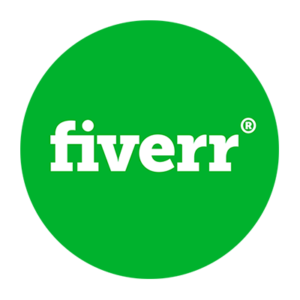 On the Fiverr site, search for “lead magnet design.”
On the Fiverr site, search for “lead magnet design.”
To make sure you have a vision for what you want your designer to create, I recommend adding yourself to lots of email lists that offer lead magnets so you can see what  other people are doing.
other people are doing.
When you find one or two that you like, attach one to your order as an example of what you’re looking for.
Your other option is to scroll through the design samples offered by Fiverr designers to find something that resonates with you and your book’s personality.
In general, I find that I get the best results on Fiverr when I can give the designer an example of the type of look I’d like to have.
Designrr
Designrr is my new favorite toy. I paid $27 for this web-based software that lets me take content I’ve already created on my blog, in a Word file, on Facebook, or on a web page — and turn it into a range of end products.
When I wanted to create a special free gift for a conference I spoke at recently, I used Designrr to turn a blog post into a short report. The nerd in me enjoyed exploring the templates and imagining the many design options for the audience handout.
You’ll get a PDF as well as a URL that houses the PDF. Give that URL to people who add themselves to your list.
Canva
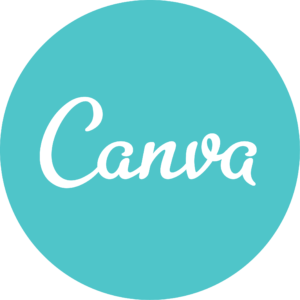 While Canva is free, if you aren’t familiar with it already, it will be your most time-intensive option as you review templates and learn how to customize or replace elements.
While Canva is free, if you aren’t familiar with it already, it will be your most time-intensive option as you review templates and learn how to customize or replace elements.
Start by typing “lead magnet” into the search box to get a nice selection of options and templates. Or, if you know what you want — say, an e-book — simply type that term into the search box.
Alternatively, on the home page, select “browse all” in small type in the upper right, just under the large search box. Scroll down to see all options. Best bets are documents, education, marketing, and events categories. Click around each collection to find something that speaks to you.
“A4 document” in the “documents” collection and “announcement” in the “events” collection offer appropriate templates and inspiration.
Need a lead magnet idea for your book? Join the Build Book Buzz book marketing group on Facebook and start a discussion. Tell us you’re looking for help with a lead magnet idea, provide your book title, and give us a short book description. Let’s rally the troops to help you if you need it!
What are you using as an incentive to get people on your list? Tell us in a comment.
]]>